

Medical Isotope Browser
IAEA Nuclear Data Section
IAEA Nuclear Data Section
• Quick start use the tips below
to
avoid
manual filling
of the input
• Examples already
prepared
runs
to show the
possible options
 Hover on one of the
examples to see how the fields are filled
Hover on one of the
examples to see how the fields are filledClick to run the selected example
• Recall previous run
keep
track
of what you already did
 Previous run are memorized
Previous run are memorizedHover on one of the items to see how the fields were filled
Click to run the selected item
• Guide go through the details of
the
Medical
Isotope Browser
• Product
 Valid
formats
Valid
formats
99TC TC99 99-TC TC-99 TC 99 99 TC
Place the meta state in the near field as "M" or "G".
"show all" plots the activity of every produced nuclide, otherwise only the selected one and the sum of rest are plotted
• Target
 Valid formats:
Valid formats:
100MO MO100 100-MO MO-100 MO 100 100 MO
Natural isotopic composition: input the element without mass (MO)
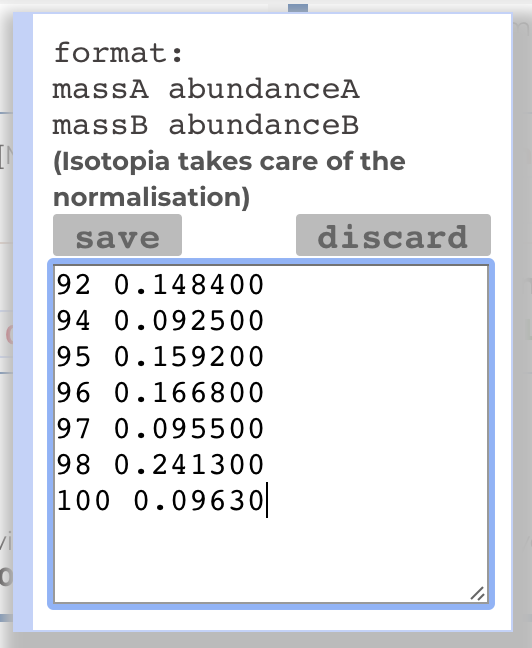 Custom composition
Custom composition
The "composition" button opens the input form (only for the element specified int Target field). Format
"mass" + " " + "value" (new line to add other masses)
The sum of the values can be any. Isotopia takes care of the normalisation
• Density
Leave the field blank to use the default value, which will be displayed in the output, or place your
value
• Thickness / Exit energy


Warning: for a given Exit Energy (Thickness), the Thickness (Exit Energy) is estimated using an approximation of the Bethe-Bloch formula, which might be inaccurate for low energies or very thin targets
• Energy range
 An energy range is sampled.
An energy range is sampled. One can choose to keep a fix Target Thickness or a fix Exit Energy .
The Exit energy and 3D buttons will be enabled:
 Exit energy or Target thickness
Exit energy or Target thickness as function of the Incident energy

a 3D plot of time, energy, and activity
• Cross section
 Cross section
Cross section To input your own cross-section, press "User defined"
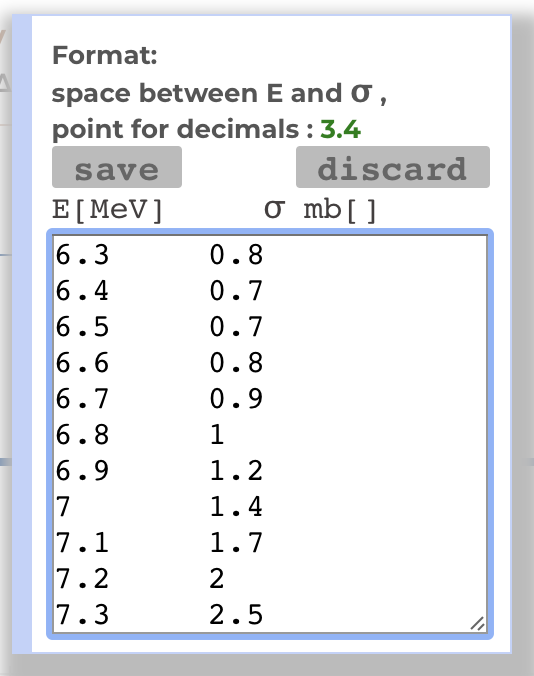
Input energy in Mev and cross section in mb, separated by a space, use point as decimal separator

Hover the mouse on the top-right on the
plot.
Dowloading, zooming, and other actions are available
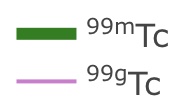
Click on a legend item to hide/show the line.
Double click to isolate the line
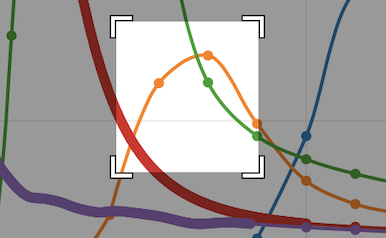
Drag a rectangle to zoom on it. Double-click anywhere to restet the chart
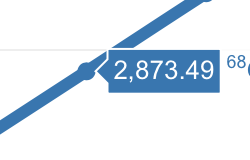 |
Click on a line to access structure and decay data of the nuclide | 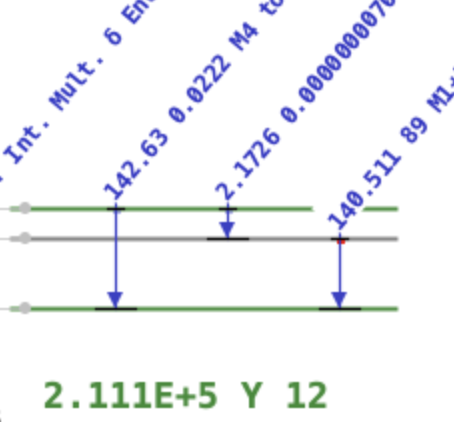 |
 Toggle linear / logarithmic y axis scale
Toggle linear / logarithmic y axis scale

Use this button to open the settings panel shown below
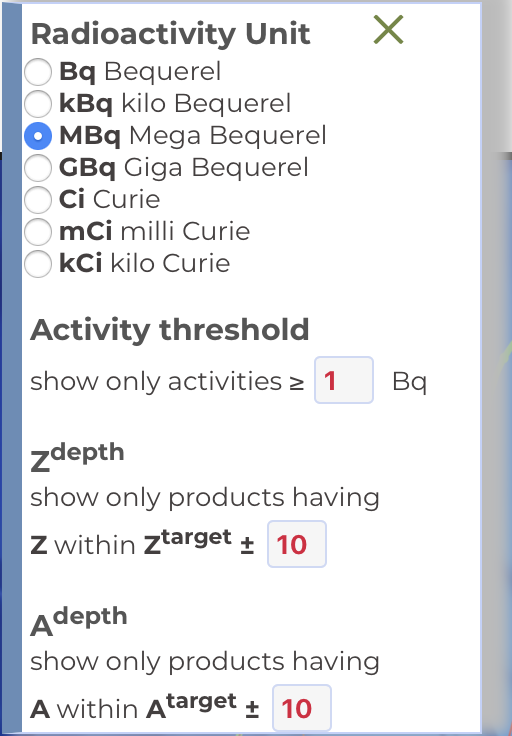
Choose the units you prefer
Remove from the plots the activities you might not need to display
Set the maximum target-product Z-distance
Set the maximum target-product A-distance
Where available the cross sections from IAEA-evaluated libraries (see below) are used. These are
extended to
the
0 - 200 MeV range using TENDL data
For reactions not covered by IAEA-evaluated cross sections, TENDL is used.
Each cross section used is labelled with the source library, and, in case of IAEA-evaluated ones, are also given the energies for which the TENDL library is being used to complete the 0 - 200 MeV range
IAEA cross sections
have been evaluated in a series of IAEA research projects that started in 2005. Numerical data and plots are available on-line at the IAEA Medical portal Medical portal
References are given below:
is a nuclear data library which provides the output of the TALYS nuclear model code system. TENDL home page
For reactions not covered by IAEA-evaluated cross sections, TENDL is used.
Each cross section used is labelled with the source library, and, in case of IAEA-evaluated ones, are also given the energies for which the TENDL library is being used to complete the 0 - 200 MeV range
IAEA cross sections
have been evaluated in a series of IAEA research projects that started in 2005. Numerical data and plots are available on-line at the IAEA Medical portal Medical portal
References are given below:
- E. Betak, A.D. Caldeira, R. Capote, B.V. Carlson, H.D. Choi, F.B. Guimaraes, A.V. Ignatyuk, S.K. Kim, B. Kiraly, S.F. Kovalev, E. Menapace, A.L. Nichols, M. Nortier, P. Pompeia, S.M. Qaim, B. Scholten, Yu. N. Shubin, J-Ch. Sublet, F. Tarkanyi: Nuclear data for the production of therapeutic radionuclides. In: S.M. Qaim, F. Tarkanyi, R. Capote (Technical editors) IAEA Technical Reports Series no. 473, IAEA scientific and technical report STI/DOC/010/473, IAEA, Vienna, Austria (2011) ISBN 978-92-0-115010-3.
- F. T. Tarkanyi, A. V. Ignatyuk, A. Hermanne, R. Capote, B. V. Carlson, J. W. Engle, M. A. Kellett, T. Kibedi, G. N. Kim, F. G. Kondev, M. Hussain, O. Lebeda, A. Luca, Y. Nagai, H. Naik, A. L. Nichols, F. M. Nortier, S. V. Suryanarayana, S. Takacs, and M. Verpelli: Recommended nuclear data for medical radioisotope production: diagnostic positron emitters, J. Rad.Nucl.Chem. 319 (2019) 487-531, https://doi.org/10.1007/s10967-018-6142-4
- A. Hermanne, A. V. Ignatyuk, R. Capote, B. V. Carlson, J. W. Engle, M. A. Kellett, T. Kibedi, G. N. Kim, F. G. Kondev, M. Hussain, O. Lebeda, A. Luca, Y. Nagai, H. Naik, A. L. Nichols, F. M. Nortier, S. V. Suryanarayana, S. Takacs, F. T. Tarkanyi, and M. Verpelli: Reference cross sections for charged-particle monitor reactions, Nucl. Data Sheets 148 (2018) 338-382.
- F. T. Tarkanyi, A. V. Ignatyuk, A. Hermanne, R. Capote, B. V. Carlson, J. W. Engle, M. A. Kellett, T. Kibedi, G. N. Kim, F. G. Kondev, M. Hussain, O. Lebeda, A. Luca, Y. Nagai, H. Naik, A. L. Nichols, F. M. Nortier, S. V. Suryanarayana, S. Takacs, and M. Verpelli: Recommended nuclear data for medical radioisotope production: diagnostic gamma emitters, J. Rad. Nucl. Chem. 319 (2019) 533-666; https://doi.org/10.1007/s10967-018-6380-5
- J. W. Engle, A. V. Ignatyuk, R. Capote, B. V. Carlson, A. Hermanne, M. A. Kellett, T. Kibedi, G. N. Kim, F. G. Kondev, M. Hussain, O. Lebeda, A. Luca, Y. Nagai, H. Naik, A. L. Nichols, F. M. Nortier, S. V. Suryanarayana, S. Takacs, F. T. Tarkanyi, and M. Verpelli: Recommended Nuclear Data for the Production of Selected Therapeutic Radionuclides, Nucl. Data Sheets 155 (2019) 56-74.
is a nuclear data library which provides the output of the TALYS nuclear model code system. TENDL home page
Please address any feedback and questions to
nds.contact-point
